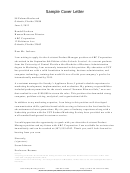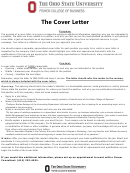The Cover Letter
ADVERTISEMENT
The Cover Letter
A cover letter must always accompany your resume. Each cover letter must be
individually written to focus your skills, experiences, abilities, and career interests
toward that position and that employer. Do not produce form letters. The letter should
be perfect in terms of spelling, punctuation, and grammar because it is a sample of your
writing skills.
Basics
Length should be one page, three to five paragraphs.
Produce on the same color and quality of paper as your resume and reference
sheet.
Don't forget to sign the letter. You may also want to type “Enclosure: Resume” in
the bottom left margin if your resume is enclosed.
Structure and Content of an Effective Cover Letter
Your Street Address
City, State, Zip Code
Date
Employer's Name, Title
Company/Organization
Street Address
City, State, Zip Code
Dear __________:
The salutation should be addressed to a specific contact person, for
example, "Mr. Brown" or "Ms. Smith." If you don't know the name,
use the person's title, e.g., “Dear Hiring Manager.”
INTRODUCTION includes:
The introduction should explain the reason you're writing--including mention of
the particular job you're interested in--and perhaps a brief statement of your
qualifications that leads into the body section.
MAIN BODY includes:
Here you should present your relevant experiences and skills. Use specific examples
that show why you'd be suited for this job. Show a knowledge of the company by
explaining why you'd be the best candidate for the position.
CLOSING includes:
Conclude politely and positively ("I look forward to meeting with you to discuss
this position...") Include your contact information. Thank the contact person for
his or her consideration.
Sincerely (or Yours)
Signature
Your Name
Enclosure: Resume (if your resume is enclosed)
University Writing Center
407-823-2197
\W:\UWC Archive\UWC Backup\UWC\HANDOUTS\Public Handouts\Lit Rack 4\Sample Cover Letters.docJan-10
ADVERTISEMENT
0 votes
Related Articles
Related forms
Related Categories
Parent category: Letters
 1
1 2
2








